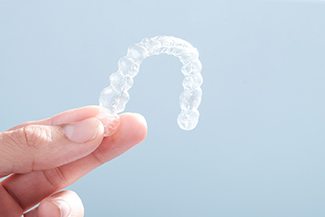SureSmile – Melbourne, FL
Enjoy an Invisible Solution for a Straight Smile
Did you know you can get straight teeth without brackets and wires? You can enjoy an FDA-approved treatment that is virtually invisible. SureSmile in Viera is the preferred orthodontic choice among teens and adults who want to correct their bite and alignment concerns. A series of clear plastic aligners discreetly move your teeth to give you the confidence you need to smile brightly throughout your treatment. Dr. Cedric C. Chenet will give you the smile of your dreams without metal braces.
Is SureSmile Right for Me?

Now, SureSmile can correct a variety of bite and alignment cases. It is effective for treating gapped, overcrowded, rotated, or tilted teeth without brackets and wires. If any of these issues sound familiar, you may be a candidate for the clear aligners. Your dentist in Viera, Dr. Chenet performs the comprehensive consultation you need to ensure SureSmile is right for you.
SureSmile Treatment Process

To start your journey to a straight smile, Dr. Chenet takes a digital impression of your mouth to create a 3D model. This is used to map the movement of your teeth through custom-fabricated clear aligners. Your series of aligners gradually move your teeth into position. On average, it takes about 12 months to finish your series. At the end of your treatment, you will briefly require a retainer.
During your treatment, you must be committed to wearing the aligners for at least 22 hours per day, only taking them out when eating, drinking, or caring for your teeth. You can expect to wear each one in the series for about 1 week before switching to the next. Since no wires are used to move your teeth, you do not need appointments for adjustments, so you will spend less time in the dental office. You will still need to come in every few weeks to allow Dr. Chenet to monitor the movement of your teeth.
Benefits of SureSmile
SureSmile offers several advantages that are not possible with traditional braces, such as:
- Nearly invisible for a discreet treatment.
- Custom-fit to eliminate slipping when speaking and smiling.
- Smooth aligners prevent irritation to the lips and cheeks.
- No dietary restrictions because the aligners are removable.
- Easy oral hygiene and aligner care.
- Less time in the dental office for a convenient treatment.
- Quick results.
Understanding the Cost of SureSmile

When determining if SureSmile is the right teeth-straightening solution for you, it’s natural to wonder about the price. However, the cost of clear aligners varies since it’s determined entirely on the patient’s dental needs and smile goals. Luckily, there are a few all-encompassing factors that play a role, and learning what they are can help you navigate the financial side of your care. To learn more, read on!
Factors That Affect the Cost of SureSmile

As mentioned above, SureSmile in Melbourne isn’t a one-size-fits-all treatment. Each patient’s treatment plan (and the accompanying cost) will be determined by several factors, including:
- If any preliminary treatments are needed, like gum disease therapy
- How many clear aligners are necessary
- Whether you’re straightening both arches or one
- If additional accessories are needed, like rubber bands
- Your compliance with treatment, like wearing your aligners for 20-22 hours a day
SureSmile vs. Smile Direct Club™: Which Costs More?

In recent years, DIY clear aligner companies like Smile Direct Club™ have convinced patients to invest in their treatment under the guise that it’s equally as reliable but more cost-effective. Unfortunately, what they don’t tell patients is that while it does usually cost around $2,000, the trays are made out of cheap plastic, there are no in-person appointments with a dental professional, there are numerous accounts of patients experiencing worsened alignment, and notable organizations (like the American Dental Association) do not approve of these treatments. So, while SureSmile may have a higher upfront cost, it’s worth the investment.
Does Dental Insurance Cover SureSmile?

Of course, the answer depends entirely on your dental plan. While some patients only have coverage for essential preventive and restorative dentistry, others can take advantage of a once-in-a-lifetime benefit for orthodontic treatment. Don’t worry – our team will be happy to review your dental insurance benefits to help make understanding the cost of SureSmile in Melbourne a breeze.
Options for Making SureSmile Affordable

If you don’t have dental insurance, that’s okay! Our knowledgeable team can still help you navigate the financial aspects of your care. In addition to welcoming all major credit cards, we also have an in-house dental savings plan and happily accept CareCredit. As a result, you can get the smile-enhancing treatment of your dreams without compromising your bank account. Again, our team will happily review each of these options during your initial consultation.
SureSmile FAQs
Does Wearing the SureSmile Aligners Hurt?
SureSmile works by exerting a gentle, constant force on your teeth to gradually shift them into the ideal position. For this reason, some patients experience a kind of “pressure” for the first few days after beginning treatment. This minor discomfort is completely normal – in fact, it’s a sign that your treatment is working! It should subside after a few days at most. In the meantime, you can take over-the-counter pain medications like acetaminophen as needed.
Is There Anything I Can’t Eat During SureSmile Treatment?
Not at all! Because the aligners are removable, you can simply take them out before enjoying your favorite foods. This is a major benefit over metal braces, since they come with a laundry list of foods you should avoid because they could damage or get stuck in your brackets and wires.
Will Wearing the Aligners Affect My Speech?
It may take a few days for your tongue to get used to the fact that the aligners are in your mouth. During that time, you may have a slight lisp. This is because several of the sounds you make are created by placing your tongue to the spot where your palate meets the back of your front teeth. Since the aligners now occupy that spot, your tongue might get confused. Don’t worry, though – it shouldn’t take more than a week for you to fully adjust. You can speed this process along by repeatedly saying words with “s” sounds aloud, like “Mississippi” or “sixty-six.”
Can I Get SureSmile If I’ve Had Braces in the Past?
Absolutely! Many patients who have previously worn braces have had their teeth revert back to their original misaligned state several years later, especially if they didn’t wear their retainer. If this has happened to you, you might very well be able to achieve a straight smile again with SureSmile.
Will SureSmile Work If I Have Dental Work Like Veneers, Crowns, or Bridges?
The answer to this question depends on your unique situation. If you have veneers or crowns, there’s a chance you could still get SureSmile, but we’ll have to thoroughly evaluate your mouth to determine your eligibility. In the case of dental bridges, SureSmile may not work. Bridges connect two or more teeth, and the aligners are meant to shift each tooth individually, so they might not be effective.
